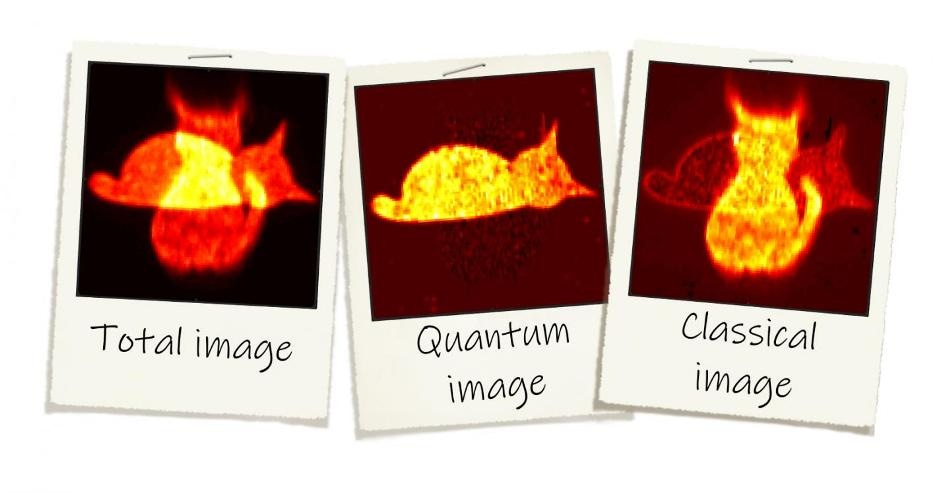Oct 25 2019
Existing microarray laser scanning technology and super-resolution microscopes are known for their very good resolutions and high sensitivities. However, these techniques use high light power to analyze samples, where the samples could be light-sensitive and thus become perturbed or damaged upon being illuminated by these devices.
 The total image or direct intensity image is obtained by the accumulation of light on the camera. With the technique, researchers are able to separate the quantum image of the “dead cat,” and then subtract this image from the total image to obtain the classical image of the “alive cat.” (Image credit: © University of Glasgow/H. Defienne)
The total image or direct intensity image is obtained by the accumulation of light on the camera. With the technique, researchers are able to separate the quantum image of the “dead cat,” and then subtract this image from the total image to obtain the classical image of the “alive cat.” (Image credit: © University of Glasgow/H. Defienne)
Currently, imaging methods that involve the use of quantum light are gaining considerable attention. This is because their capabilities with regards to sensitivity and resolution can exceed classical limitations; moreover, they do not damage the sample. This is feasible because quantum light is emitted as single photons and it uses the feature of entanglement to get to lower light intensity regimes.
Although the use of quantum detectors and quantum light has been steadily developing in the recent past, a few challenges should still be solved. Quantum detectors are themselves sensitive to classical noise, which may be so high that it can decrease or even cancel out any type of quantum advantage over the acquired images.
The European project Q-MIC, which was introduced a year ago, has brought together an international group of researchers with expertise in different fields. The researchers have joined hands to create and apply quantum imaging technologies to develop a quantum enhanced microscope with the potential to go beyond the capabilities of existing microscopy technologies.
In a study reported recently in Sciences Advances, scientists Hugo Defienne and Daniele Faccio from the University of Glasgow and collaborators of the Q-MIC project have described a new technique that involves using image distillation to derive quantum information from an illuminated source consisting of both classical and quantum information.
As part of the experiment, the scientists used two sources to create an integrated final image of a “dead” and “alive” cat. A quantum source triggered by a laser used to form entangled pairs of photons, which illuminated a crystal and passed through a filter to generate an infrared image (800 nm) of a “dead cat,” or the so-called “quantum cat.”
At the same time, they created the image of an “alive cat” by using a classical source with an LED. Subsequently, they used an optical setup to superimpose both images and transmitted them to a special CCD camera called an electron-multiplied charge-coupled device (EMCCD).
Using this setup, they could see that, in general, both light sources have the same spectrum, polarization, and average intensity. Thus, the sources could not be distinguished through a single measurement of just the intensity. However, photons coming from the coherent classical source (i.e. the LED light) are uncorrelated, whereas the photons coming from the quantum source (i.e. photon pairs) are correlated in position.
With the help of an algorithm, the researchers could apply these photon correlations in position to separate the conditional image at which two photons arrive at adjacent pixels on the camera and recover just the “quantum illuminated” image. As a result, the classical “alive cat” image was also recovered by subtracting the quantum image from the direct total intensity image.
Another unexpected problem caused by this technique is that the scientists could also derive reliable quantum information even when the classical illumination was 10 times greater. They demonstrated that even when there was a decrease in the quality of the image due to a decrease in the high classical illumination, a sharp image of the shape of quantum image could still be obtained.
This method paves a new way for quantum imaging and quantum enhanced microscopes with the aim to analyze ultra-sensitive samples. Moreover, the outcomes of this research demonstrate that this method could be of high significance for quantum communications.
The potential to blend and derive particular information carried by both classical and quantum light could be applied for encoding information and for encryption methods. Specifically, it could be applied to encrypt or hide information encoded in a signal while using traditional detectors.
This approach brings a change in the way we are able to encode and then decode information in images, which we hope will find applications in areas ranging from microscopy to covert LIDAR.
Prof. Daniele Faccio, ICFO